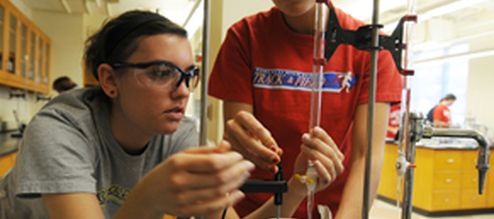Document Type
Article
Publication Date
5-2008
Publication Source
Journal of Heterocyclic Chemistry
Abstract
Chlorination and bromination reactions of thiazolo[5,4-d]thiazole led to the generation of its mono- and dihalogenated derivatives. These are the first instances of successful direct electrophilic aromatic substitution in the thiazolo[5,4-d]thiazole ring system. X-ray analysis demonstrates that both 2-bromothiazolo[5,4-d]-thiazole and 2,5-dibromothiazolo[5,4-d]thiazole are planar structures, with strongly manifested π-stacking in the solid state. Theoretical analysis of the pyridine-catalyzed halogenation (MP2/6-31+G(d) and B3LYP/6-31+G(d)calculations) reveals that introduction of one halogen actually leads to a slightly enhanced reactivity towards further halogenation. Several halogenation mechanisms have been investigated: 1) The direct C-halogenation with N-halopyridine as electrophile; 2) C-halogenation viaintermediate N-halogenation, and 3) C-halogenation following an addition - elimination pathway, with intermediate formation of a cyclic halonium ion. The theoretical studies suggest that the direct C-halogenation is the favored mechanism.
Inclusive pages
811-819
ISBN/ISSN
0022-152X
Document Version
Postprint
Copyright
Copyright © 2008, John Wiley & Sons
Publisher
John Wiley & Sons
Volume
45
Peer Reviewed
yes
Issue
3
eCommons Citation
Benin, Vladimir; Yeates, Alan T.; and Dudis, Douglas, "Preparation of Halogenated Derivatives of Thiazolo[5,4-d]thiazole via Direct Electrophilic Aromatic Substitution" (2008). Chemistry Faculty Publications. 11.
https://ecommons.udayton.edu/chm_fac_pub/11
Included in
Analytical Chemistry Commons, Biochemical Phenomena, Metabolism, and Nutrition Commons, Chemical and Pharmacologic Phenomena Commons, Environmental Chemistry Commons, Inorganic Chemistry Commons, Materials Chemistry Commons, Medical Biochemistry Commons, Medicinal-Pharmaceutical Chemistry Commons, Organic Chemistry Commons, Other Chemistry Commons, Physical Chemistry Commons




Comments
The document available for download is the authors' accepted manuscript, posted here in compliance with the publisher's policy on self-archiving.
Some differences may exist between this version and the publisher's version; as such, researchers wishing to quote directly from it are advised to consult the version of record, available at many libraries or from the publisher.
Permission documentation is on file.